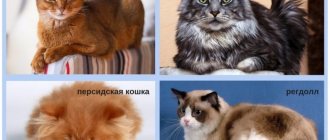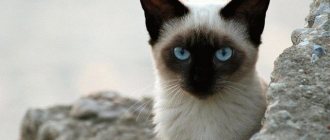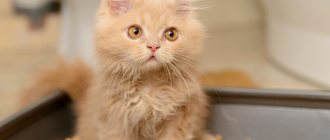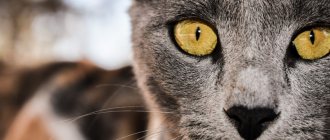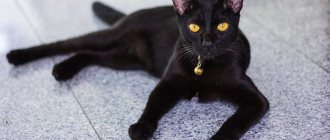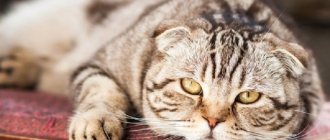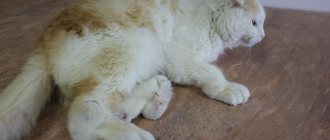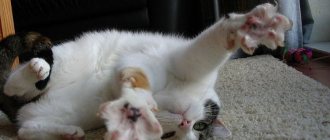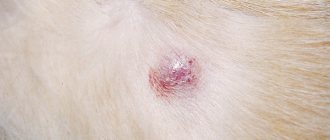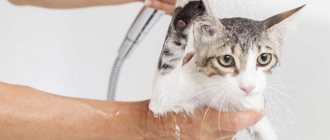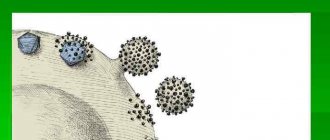Heart failure is the inability of the heart to pump the amount of blood the body needs. This disease occurs as a result of past infectious diseases. Heart failure is the most common cause of sudden death in pets. It affects not only dogs, but also cats.
Types of heart failure:
- Chronic heart failure. It develops slowly, sometimes imperceptibly, but at the same time, steadily.
- Acute heart failure develops quite rapidly, its time varying from several minutes to several hours.
As a result of the acute form, the cat instantly develops pulmonary edema, symptoms of which may include blood discharge from the mouth and nose, as well as shortness of breath.
Symptoms
Symptoms of heart disease in cats are not always visible, but she cannot complain about her health. Therefore, the health of the pet is entirely in the hands of the owner. He must monitor his pet and, upon discovering the first symptoms of the disease, should seek advice from a veterinarian.
A cat's panting with a protruding tongue is a sign of heart disease.
- Fatigue is difficult to notice in a cat, since it leads a generally quiet lifestyle.
- Dyspnea. Breathing occurs through the abdomen, without the participation of the chest.
- An attack accompanied by loss of consciousness. The cat, at this time, can be mistaken for a dead animal. Usually the attack passes quickly, but it happens that pets die, as their body experiences an acute lack of oxygen.
- The animal wheezes and meows terribly.
- Heavy breathing indicates pulmonary edema.
- Complete or partial paralysis of the hind legs.
- Cardiopalmus.
- Cyanosis of the gums.
- Loss of appetite.
In cats, coughing is not a cardiac symptom.
First aid for a cat who faints
The onset of an attack requires quick and correct actions by the owner, since, sometimes, it can end in death.
- Lay the cat down, and it is necessary to give her a side position of her head.
- Pull out your tongue.
- Place a cool compress on your head.
- Place cotton wool soaked in ammonia to your nose.
- The paws must be fixed higher than the head, so there will be more blood flow to the head.
- Call your veterinarian.
How to distinguish a healthy cat from a sick one
Since cats generally lead a calm lifestyle, they are couch potatoes, not all owners can distinguish a healthy animal from a sick one. She can report any changes in well-being by changing her behavior, that is, if the cat used to behave independently of the owner, but now does not leave him, then this indicates that something is bothering her.
Some people think that purring in cats is a sign of health. This is wrong. Purring, abruptly replaced by aggression or growling, indicates that she is in pain.
A healthy animal has:
- Smooth wool.
- The nose is wet and cold.
- The mucous membranes of the eyes are pinkish in color.
- The animal is vigorous and active.
Sick animal:
- Lethargic, lies more than usual.
- He tries to get away from everyone to a secluded place.
- Can be very excited.
- The meow is pitiful.
- Movements are clumsy.
- The nose is warm with cracks.
Symptoms of the disease
The main manifestations of hypertrophic cardiomyopathy are poor exercise tolerance and shortness of breath. If the disease is asymptomatic, there is a high probability of death due to thromboembolism, which develops as a result of pulmonary edema.
Dyspnea and paralysis are common in HCM
The main signs of HCM are the following symptoms:
- Physical state. An exhausted animal loses interest in active games and sleeps a lot.
- Breath. Severe, accompanied by wheezing and gurgling. Under heavy load, the pet experiences difficulty in inhaling. This is caused by slowing down the movement of blood in the veins. The cat breathes with its belly, sticking out its tongue.
- Dyspnea. Attacks of suffocation often lead to fainting as a result of lack of oxygen.
- Character of the pulse. Filiform.
- Condition of mucous membranes. Due to oxygen starvation, the shells acquire a blue tint.
- Cough. Reflex, caused by excessive pressure of an enlarged heart on the trachea. To cope with an attack, the cat sticks out its neck, spreading its forelimbs for greater ventilation.
- Hydrothorax and ascites. The release of exudate contributes to the formation of swelling in the peritoneum and chest.
- Paralysis of the hind limbs. If a blood clot blocks the lumen in the vessels, the animal’s legs in the pelvic area fail.
- Body mass . Poor weight gain.
- Heart murmurs and tachycardia.
If you notice any of the symptoms, take your pet to the veterinarian
Causes of heart failure
- Congenital heart pathologies. In cats they are quite rare, occurring in approximately 2% of all cases.
- Diseases of the heart muscle caused by infectious diseases.
- Cardiomyopathy, which is caused by an inadequate diet in cats. They, as a rule, do not receive enough taurine, which is part of raw fish and meat. During cooking, it is destroyed.
- Heartworms and their larvae are found in mosquitoes. They are microscopic in size. When a mosquito bites, their larvae enter the animal’s bloodstream and settle in the pulmonary artery. Heartworms can grow up to 30 centimeters in size. With their presence in the circulatory system, they interfere with the outflow of blood and cause enormous damage to the arteries. Adults entangle the heart, thereby interfering with its full functioning. Heartworms can be detected using a blood test.
- Age-related hormonal changes. Heart failure is thought to occur in cats over 6 years of age.
- Metabolic disease. Sometimes it is caused by improperly structured nutrition.
Cats should be periodically screened for heartworms to help prevent heart disease. If a taurine deficiency is noticed in a timely manner, it must be introduced into the cat’s food, due to which the vital activity of the heart muscle is restored.
Diagnostics
Diagnosis must be carried out by a qualified veterinary cardiologist in order to prescribe the correct treatment. Typically it includes:
- Blood analysis.
- Analysis of urine.
- Ultrasound.
- Chest X-ray.
- ECG.
If a cat has been diagnosed with heart failure, then it should be excluded from planning for breeding, since the hereditary factor plays an important role.
Hyperkinetic circulatory disorders.
Factors leading to damage to the heart muscle have different development mechanisms. Among them are:
- Valve pathologies (stenosis, atresia, aplasia).
- Insufficient compression or incomplete relaxation of the myocardium.
- Arrhythmias.
- Vascular diseases that result in increased resistance to blood flow.
- Shunts between the chambers of the heart.
- Heartworm infection.
- Influence of infectious agents.
In most cases, heart failure develops as a result of these factors. If there is insufficient outflow of blood from the organs, then it is accordingly called stagnation.
These are heart diseases that do not exist at birth, but develop during life. They can be of a primary or secondary nature.
Arrhythmias (heart rhythm disturbances).
Changes in the heart's electrical impulses disrupt the natural rhythm of the heart, causing various arrhythmias. Oxygen deficiency in the heart muscle, acid-base imbalance, electrolyte imbalances, drugs, toxins and heart disease can cause arrhythmias.
Most cardiac disorders associated with electrolyte imbalance occur in response to changes in serum potassium levels. An imbalance in calcium, sodium, magnesium, and hydrogen can also cause critical disturbances in myocardial conductivity.
Atrial and ventricular extrasystoles occur when there are premature electrical impulses originating outside the sinoatrial node (natural pacemaker). They are often prescribed in cats with hypokalemia (low serum potassium). Hypokalemia may occur with chronic episodes of severe vomiting or diarrhea, or with excessive loss of potassium in the urine (kidney disease, due to the use of diuretics or insulin). Treatment is based on correcting the cause of hypokalemia (for example: gastrointestinal, kidney problems) and infusion of potassium supplements.
Atrial and/or ventricular fibrillation occurs when the heart generates erratic electrical impulses that prevent the heart muscle from contracting fully. Atrial fibrillation is uncommon in cats, probably due to the small size of the heart, but when reported, it is usually due to hypertrophic cardiomyopathy (enlargement of the heart muscle).
Bradycardia (lower than normal heart rate) is most common in cats with urethral obstruction (a blockage of the urinary tract). Obstruction causes electrolyte disturbances (excess potassium) and metabolic acidosis, which lowers the heart rate. Severe bradycardia and conduction abnormalities in these cases must be treated immediately to avoid death.
Tachycardia (higher than normal heart rate) can be caused by hyperthyroidism (an overactive thyroid gland), known birth defects, and bacterial endocarditis (inflammation of the inner lining of the heart). Tachycardia may also be associated with fear, stress, anemia and fever.
Typically, decreased cardiac output associated with arrhythmias results in decreased blood flow to the brain, spleen, and kidneys. Antiarrhythmic drugs can help treat arrhythmias, but therapy should be aimed at correcting the underlying cause of the arrhythmia.
Diseases of the cardiovascular system in cats
Acquired heart valve diseases.
These are disorders in which one or more valves are affected by a primary pathological process. They can cause degenerative processes, systemic bacterial infections and chronic dental infections. A disease that affects the valves causes the edges of the valve to thicken and shrink, which prevents the valve from closing properly and causes blood to flow back. The result is decompensated heart failure.
Although bacterial endocarditis is uncommon in cats, it usually affects the left valves. Typical signs of infection include fever, depression and decreased appetite.
To treat the infection, broad-spectrum antibiotics are administered. If heart lesions are due to infection, your veterinarian may prescribe heart medications and diuretics to support heart function. The prognosis is favorable if treatment for bacterial endocarditis is started in a timely manner.
Myocardial diseases.
Cardiomyopathy. Cardiomyopathy is a primary disease affecting the heart muscle. The final result of the disease is the inability of the heart to compensate for stress, heart failure. Hereditary pathology, viral diseases, autoimmune mechanisms, biochemical disorders and nutritional deficiency (for example: taurine) may be involved in the development of cardiomyopathy.
Cardiomyopathies are divided into hypertrophic, dilating and contracting. There is an increasing number of cats whose heart disease cannot be classified within just these three categories. Middle-aged males of known breeds are more prone to cardiomyopathies. Most of the established signs (difficulty breathing, lameness or paralysis, depression and ascites) resulted from arrhythmias, decompensated heart failure or blood clotting.
Hypertrophic cardiomyopathy (HCM). HCM is the most common form of acquired heart disease in cats, predominantly affecting young to middle-aged males. This is an enlargement of the left ventricular wall, papillary muscles and septum, which limits the size of the left ventricular cavity.
This type of enlargement prevents the heart from stretching adequately to receive blood, so cardiac output decreases. The incidence of thrombosis is slightly higher than with other forms of cardiomyopathy. The dynamics of this thrombosis are directly related to the limitation of ventricular filling, which allows blood to remain in the left atrium for a long time, which gives a great chance for the formation of clots.
Signs suggestive of HCM include labored noisy breathing, depression, decreased appetite, and possibly lameness or paralysis of the hind limb due to thrombosis.
The prognosis is favorable if arrhythmia and blood clotting can be controlled with medications. Treatment usually consists of negative inotropes (substances that affect the force of muscle contractions), diuretics, and control doses of aspirin.
Dilational cardiomyopathy (DCM). RCM occurs primarily in middle-aged and old cats. The incidence of RCM in Siamese, Abyssinian and Burmese cats is also increased.
RCM - enlargement of all cavities of the heart. This expansion occurs as a result of muscle cells stretching, thereby thinning and weakening the heart wall.
Research has shown that taurine deficiency (an essential amino acid) may be a cause of RCM. Cat food manufacturers add taurine sources to meet the latest tauine level recommendations for cats.
Progression of the disease often leads to decompensated heart failure (DHF), especially if the animal is not treated. DHF is characterized by depression and emaciation due to decreased cardiac output. If the right ventricle or both ventricles function in concert, then fluid accumulates in the chest cavity and minimally in the abdominal cavity. Cardiogenic shock or fatal arrhythmia is often the cause of death in DHF.
Containing cardiomyopathy (endocardial fibrosis). Containment cardiomyopathy is rare in cats. In this disease, fibrous tissue covers the heart muscle, causing the heart to become rigid. This reduces the heart's ability to stretch and contract. Older cats are predominantly affected.
Diuretics and digitalis can be used for treatment. A low-salt diet may also be beneficial. The long-term prognosis is cautious.
Let's look at what diseases are most common in our pets:
- Hypertrophic cardiomyopathy (HCM). This disease accounts for 65% of all cases of heart pathologies in cats. HCM is an inherited disease that is most common in certain breeds. You can read more about this disease in our article “Cardiomyopathy in cats, symptoms and treatment of the disease.”
- Dilated cardiomyopathy (DCM) is an acquired heart disease, during which the chambers of the organ (ventricles) begin to overstretch, their walls become thinner and cannot contract normally, as a result of which the function of the heart noticeably decreases. An interesting fact: before the discovery of the value of the amino acid taurine (the disease develops when there is a lack of it in the diet), the incidence of DCM was 50% - a fairly high figure. But when scientists proved the importance of getting taurine from food, and feed manufacturers began to enrich their diets with this amino acid, the value dropped to 5%. These are very encouraging results, especially considering that the average survival time for cats after becoming fully symptomatic with DCM is only 11 days.
- Restrictive cardiomyopathy occurs in 15% of cases. This is fibrous (that is, connective tissue) degeneration of the endocardium (inner lining of the heart) or endo- and myocardium (heart muscle). In this case, the elasticity of the organ is lost, and it cannot pump blood normally. During this illness, symptoms develop quickly and the prognosis is poor.
- In 3% of cases, arrhythmogenic dysplasia of the right ventricle is detected - a disease in which fibrofatty degeneration of the heart muscle occurs.
- In 12% of feline heart diseases are secondary processes.
The last category includes heart defects - congenital and acquired, which we have already discussed in detail in the article “Heart defects in cats.” The most common congenital defects include ventricular septal defect, Tetralogy of Fallot, mitral valve dysplasia, and triscupid valve dysplasia.
Cardiovascular diseases of cats often develop as complications of any systemic diseases, such as:
- Hyperthyroidism. An overactive thyroid gland causes the heart to beat too fast and overwork, and its hormones in high concentrations are poison to the heart muscle.
- Kidney failure is not uncommon in older cats. When the kidneys do not perform their function well, this leads to disorders of all organ systems. First of all, blood pressure increases, which also adversely affects the heart.
- Lymphoma is a terrible viral disease of cats, characterized by the appearance of tumors throughout the body. She doesn't spare the cat's heart either.
- Dirofilariasis is a dangerous parasitic disease that is very common in some areas. You can read more about it in the article “Heartworms in cats: main symptoms.”
Myocarditis
- Congenital heart pathologies. In cats they are quite rare, occurring in approximately 2% of all cases.
- Diseases of the heart muscle caused by infectious diseases.
- Cardiomyopathy, which is caused by an inadequate diet in cats. They, as a rule, do not receive enough taurine, which is part of raw fish and meat. During cooking, it is destroyed.
- Heartworms and their larvae are found in mosquitoes. They are microscopic in size. When a mosquito bites, their larvae enter the animal’s bloodstream and settle in the pulmonary artery. Heartworms can grow up to 30 centimeters in size. With their presence in the circulatory system, they interfere with the outflow of blood and cause enormous damage to the arteries. Adults entangle the heart, thereby interfering with its full functioning. Heartworms can be detected using a blood test.
- Age-related hormonal changes. Heart failure is thought to occur in cats over 6 years of age.
- Metabolic disease. Sometimes it is caused by improperly structured nutrition.
Treatment and care
Treatment of cats for this disease depends on the severity of the disease. Sometimes it is carried out exclusively during a daily stay in a veterinary clinic. Cats do not undergo heart surgery. During illness, they are prescribed only drug treatment. The earlier they are diagnosed with heart failure, the better their chances of survival. For recovery you need:
- Complete rest of the animal. The pet must be limited from any stress - this could be a working vacuum cleaner, traveling on public transport or the arrival of guests.
- Treatment with diuretics removes excess fluid from the body. During illness, fluid can accumulate near the lungs, thereby causing swelling. In the chest, causing pleurisy. In the abdominal cavity, causing ascites. Reducing the amount of fluid in the body helps reduce the load on the heart.
- Treatment with ACE inhibitors, which reduce the load on the heart by increasing blood flow.
- Positive inotropes make the heart pump more blood, control the heartbeat, and slow it down so it pumps more blood into the body.
- When the fluid content in a cat’s body is greatly increased, the veterinarian will pump it out and thereby remove it from the body. The cat will feel relief for a while, but this will not last long, as the fluid will return. Pumping is carried out by inserting a sterile needle into the required place.
- Balanced diet.
Heart failure in an animal requires careful care:
- Cats need low-salt food. Salt retains water in the body, which leads to poor circulation.
- Feed with a high content of taurine and protein.
- Heart failure requires regular veterinary consultations and ongoing treatment.
Birth defects
Any congenital heart defect in a cat is very dangerous. But these pathologies are rare in cats. It is believed that congenital heart pathologies can be found in a maximum of 1% of kittens. In most cases, we are talking about improper development of the heart valves or an unclosed ductus botellus.
The mitral valve, which is located between the left atrium and the left ventricle, is often affected. The variety of possible disorders is great, but there is no point in describing them all: the fact is that, as a result of the influence of hereditary disorders, the valve simply cannot close normally, bleeding part of the blood back into the aorta when the ventricles contract. If we talk about a duct that is not overgrown with botalli, then the severity of the pathology varies depending on the diameter of the remaining hole.
Prevention
Cats suffering from heart failure need preventative care to keep them active. We need to try to “stir up” animals that lead a “sofa” lifestyle. Obese cats are at risk for heart disease. You need to ensure your pet is eating properly. An annual checkup with a veterinarian will protect him from heart disease.
Sphynx, British, Persian, Scottish cats, and Maine Coons are also susceptible to heart disease. This does not mean that all cats of these breeds, sooner or later, have heart problems. This statement means that representatives of these breeds develop heart disease at an earlier age.
Heart failure in neutered cats is quite common because these animals are very lazy. They lead a sedentary lifestyle and are obese.
It is necessary to pay increased attention to neutered cats, as they are more susceptible to heart disease.
A diagnosis of heart failure in cats is not a death sentence. The main thing is to notice the first symptoms of the disease in time, carry out regular examination and treatment. Monitor your pet's diet. With proper care and care, a cat can delight its owner with affection and beauty for a long time.
Disease prognosis
The disease development scenario is determined by the following factors:
- timely detection of the disease;
- degree of severity of symptoms;
- the presence of swelling and thromboembolism.
If the pathology is detected at an early stage, subject to proper nutrition and well-chosen therapy, the prognosis is favorable. Life expectancy is not reduced. If left untreated, the pet dies. Death occurs due to thrombosis or heart failure.
Stress can make your pet's condition worse
It is important to remember that any stress can worsen a pet’s physical condition. Therefore, it is necessary to protect the animal from emotional stress.
Diagnostics
Only a doctor can determine that a pet’s symptoms of illness relate specifically to heart disease. And often a clinical examination and listening to heart murmurs are not enough to make a diagnosis and additional examinations are needed. What may be required for diagnosis:
- History (collection of information from the owner)
- Physical examination (examination, palpation, listening with a phonendoscope (auscultation))
- Tonometry (pressure measurement)
- Electrocardiography (ECG - measurement of the electrical activity of the heart) is not an informative method for diagnosing heart disease, but is used to identify pathologies associated with circulatory rhythm disturbances
- X-ray (the main diagnostic method) - provides information about the shape and size of the heart, the condition of the lungs (the presence of edema, blood stagnation, etc.). Photos must be of high quality.
- Echocardiography (ultrasound is the main diagnostic method) - provides information about the thickness of the walls, the size and shape of the atria, the diameter of the aorta, the rhythm of contractions, the presence of blood clots, etc. Modern ultrasound machines can use the Doppler effect to assess blood flow.
[custom_ads_shortcode3]
Causes of myocardial pathology in cats
Experts in the field of veterinary medicine, based on clinical practice, identify the following causes leading to heart disease:
- predisposition at the gene level;
- violation of breeding rules (inbreeding - inbreeding, errors in selecting a breeding pair);
- sedentary lifestyle of domestic couch potatoes;
- injuries and mechanical damage to the heart muscle;
- intoxication of the body of various etiologies;
- helminthic infestations;
- concomitant diseases: diabetes mellitus, hyperthyroidism, kidney disease;
- stressful situations;
- poor feeding, especially deficiency of taurine in the diet.
Many breeders and veterinarians note that breeds such as Maine Coon, Ragdoll, and Persian cats are most susceptible to diseases of the heart muscle. Acquired pathologies often begin to appear in animals aged 6 years and older.
Acquired vices
Sometimes an animal is born healthy, all the holes in the heart, as expected, close almost immediately after birth, but in the future one or another defect is still diagnosed. This occurs due to changes throughout life under the influence of various factors. Here are the main reasons that are typical for the development of defects in domestic cats:
- sedentary lifestyle;
- poor nutrition (lack of nutrients, including taurine);
- obesity;
- endocrine diseases (diabetes mellitus, hyperthyroidism);
- suffered severe viral and bacterial infections.
The heart valves are most often affected. They stop closing tightly, and when the heart muscle contracts, some of the blood flows back instead of moving forward.
Initially minor disorders only progress with age and lead to a cascade of other pathologies - problems grow like a snowball. For example, if some of the blood gets back, then the chambers of the heart stretch too much, their walls become thinner, the muscles weaken and cannot ensure full contraction of the atrium or ventricle. Symptoms of heart failure develop.
Improper blood circulation affects the entire animal’s body and leads to a number of problems that, at first glance, are not related to the heart, and therefore the exact cause of the cat’s poor health can only be determined by a veterinarian using modern diagnostics.
How is a heart defect diagnosed in a cat?
A veterinarian may also suspect a heart defect during a routine examination of the animal if he detects certain murmurs when listening to the cat’s heart. The best option would be further examination by a veterinary cardiologist.
The well-known electrocardiogram (ECG), which every person regularly undergoes during medical examination, is considered so uninformative for cats that it is practically not used. Most often, doctors examine the heart using echocardiography (ECHO), or ultrasound of the heart, during which the doctor can evaluate the functioning of the organ and the direction of blood flow.
Sometimes an X-ray of the chest cavity is also taken. It helps assess the size of the heart and its location in the body. To assess the condition of the whole organism, a clinical blood test and standard detailed biochemistry are also required.
